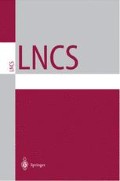Abstract
Networks of workstations are becoming increasingly popular as a cost-effective alternative to parallel computers. Typically, these networks connect pro- cessors using irregular topologies, providing the wiring flexibility, scalability and incremental expansion capability required in this environment. Recently, we pro- posed a design methodology as well as fully adaptive routing algorithms for irreg- ular topologies. These algorithms increase throughput considerably with respect to previously existing ones but require the use of virtual channels.
In this paper we propose a very efficient flow control mechanism to support virtual channels when link wires are very long, and/or have different lengths. This flow control mechanism relies on the use of channel pipelining and control flits. Control traffic is minimized by assigning physical bandwidth to virtual channels until the corresponding message blocks or it is completely transmitted. Simulations show that the resulting flow control protocol performs almost as efficiently as an ideal network with short wires and flit-by-flit multiplexing.
This work was supported by the Spanish CICYT under Grant TIC94-0510-C02-01
Access this chapter
Tax calculation will be finalised at checkout
Purchases are for personal use only
Preview
Unable to display preview. Download preview PDF.
References
M. A. Blumrich, K. Li, R. Alpert, C. Dubnicki, E. W. Felten and J. Sandberg, “Virtual memory mapped network interface for the SHRIMP multicomputer,” Proceedings of the 21st International Symposium on Computer Architecture, pp. 142–153, April 1994.
N. J. Boden, D. Cohen, R. E. Felderman, A. E. Kulawik, C. L. Seitz, J. Seizovic and W. Su, “Myrinet-A gigabit per second local area network,” IEEE Micro, pp. 29–36, February 1995.
R. V. Boppana and S. Chalasani, “A comparison of adaptive wormhole routing algorithms,” in Proceedings of the 20th International Symposium on Computer Architecture, May 1993.
A. A. Chien and J. H. Kim, “Planar-adaptive routing: Low-cost adaptive networks for multiprocessors,” in Proc. of the 19th International Symposium on Computer Architecture, May 1992.
W. J. Dally and C. L. Seitz, “Deadlock-free message routing in multiprocessor interconnection networks,” IEEE Transactions on Computers, vol. C-36, no. 5, pp. 547–553, May 1987.
W. J. Dally, “Virtual-channel flow control,” IEEE Transactions on Parallel and Distributed Systems, vol. 3, no. 2, pp. 194–205, March 1992.
B. V. Dao, S. Yalamanchili and J. Duato, “Architectural support for reducing communication overhead in pipelined networks,” Third International Symposium on High Performance Computer Architecture, February 1997.
J. Duato, “On the design of deadlock-free adaptive routing algorithms for multicomputers: Design methodologies,” in Proceedings of Parallel Architectures and Languages Europe 91, June 1991.
J. Duato, “A new theory of deadlock-free adaptive routing in wormhole networks,” IEEE Transactions on Parallel and Distributed Systems, vol. 4, no. 12, pp. 1320–1331, December 1993.
T. von Eicken, D. E. Culler, S. C. Goldstein and K. E. Schauser, “Active messages: A mechanism for integrated communication and computation,” in Proceedings of the 19th International Symposium on Computer Architecture, June 1992.
R. Horst, “Server Net deadlock avoidance and fractahedral topologies,” in Proceedings of the International Parallel Processing Symposium, pp. 274–280, April 1996.
J.-M. Hsu and P. Banerjee, “Performance measurement and trace driven simulation of parallel CAD and numeric applications on a hypercube multicomputer,” IEEE Transactions on Parallel and Distributed Systems, vol. 3, no. 4, pp. 451–464, July 1992.
V. Karamcheti and A. A. Chien, “Do faster routers imply faster communication?,” in Proceedings of the Workshop on Parallel Computer Routing and Communication, May 1994.
R. J. Littlefield, “Characterizing and tuning communications performance for real applications,” in Proceedings of the First Intel DELTA Applications Workshop, February 1992.
L. M. Ni and P. K. McKinley, “A survey of wormhole routing techniques in direct networks,” IEEE Computer, vol. 26, no. 2, pp. 62–76, February 1993.
W. Qiao and L. M. Ni, “Adaptive routing in irregular networks using cut-through switches,” in Proceedings of the 1996 International Conference on Parallel Processing, August 1996.
M. D. Schroeder et al., “Autonet: A high-speed, self-configuring local area network using point-to-point links,” Technical Report SRC research report 59, DEC, April 1990.
S. L. Scott and J. R. Goodman, “The Impact of Pipelined Channels on k-ary n-Cube Networks,” in IEEE Transactions on Parallel and Distributed Systems, vol. 5, no. 1, pp. 2–16, January 1994.
F. Silla, M. P. Malumbres, A. Robles, P. López and J. Duato, “Efficient Adaptive Routing in Networks of Workstations with Irregular Topology,” in Proceedings of the Workshop on Communications and Architectural Support for Network-based Parallel Computing, February 1997.
F. Silla and J. Duato, “Improving the Efficiency of Adaptive Routing in Networks with Irregular Topology,” in Proceedings of the 1997 Int. Conference on High Performance Computing, December 1997.
Author information
Authors and Affiliations
Editor information
Editors and Affiliations
Rights and permissions
Copyright information
© 1998 Springer-Verlag Berlin Heidelberg
About this paper
Cite this paper
Silla, F., Duato, J. (1998). On the Use of Virtual Channels in Networks of Workstations with Irregular Topology. In: Yalamanchili, S., Duato, J. (eds) Parallel Computer Routing and Communication. PCRCW 1997. Lecture Notes in Computer Science, vol 1417. Springer, Berlin, Heidelberg. https://doi.org/10.1007/3-540-69352-1_18
Download citation
DOI: https://doi.org/10.1007/3-540-69352-1_18
Published:
Publisher Name: Springer, Berlin, Heidelberg
Print ISBN: 978-3-540-64571-9
Online ISBN: 978-3-540-69352-9
eBook Packages: Springer Book Archive

